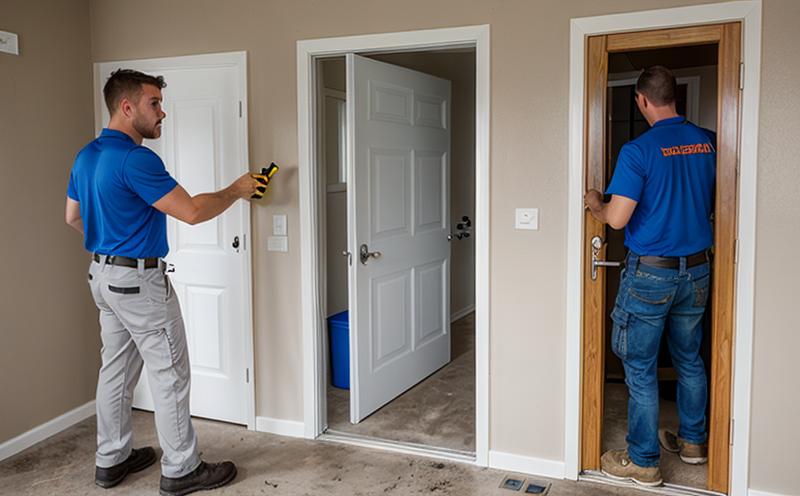Access door inspection
The importance of access doors in HVAC and ventilation systems cannot be overstated. These doors provide essential access points for maintenance and inspections, ensuring that the integrity and functionality of the entire system are maintained over its lifecycle. Access doors are critical components that play a pivotal role in the overall efficiency and safety of HVAC and ventilation systems.
During an inspection, the focus is on verifying that these doors meet specific design criteria and functional standards. The primary goal is to ensure that access points are properly sealed, preventing air leakage, which can lead to increased energy consumption and reduced operational efficiency. A well-executed inspection also includes checking for any signs of corrosion or damage that could compromise the structural integrity of the door.
The process typically begins with a visual examination of the door, followed by a detailed assessment using specialized tools such as infrared cameras and pressure testing equipment to detect leaks and ensure proper sealing. The use of these advanced technologies allows technicians to identify potential issues that might not be apparent during a standard inspection.
Once identified, any deficiencies are documented in detail. A comprehensive report is then prepared outlining the findings along with recommendations for corrective actions. This ensures that necessary repairs or replacements can be scheduled promptly, minimizing downtime and preventing further deterioration of the system. The report also serves as valuable data for quality managers and compliance officers to monitor performance and adherence to industry standards.
Compliance with relevant international standards is crucial in this context. For instance, ASHRAE (American Society of Heating, Refrigerating and Air-Conditioning Engineers) guidelines provide stringent criteria that HVAC systems must meet regarding access door design and functionality. Similarly, ISO 13438 specifies requirements for air tightness testing of building structures including doors.
In addition to ensuring operational efficiency, proper maintenance through regular inspections helps extend the lifespan of HVAC systems, reducing long-term costs associated with premature replacement. By adhering to best practices during access door inspection, organizations can significantly enhance their overall sustainability efforts while maintaining high levels of comfort and safety within occupied spaces.
Applied Standards
The inspection process for access doors in HVAC systems is governed by several key standards which ensure consistency across various applications. One such standard is ASHRAE 130, which specifies minimum criteria for door design in commercial buildings to promote efficient operation and maintenance of HVAC equipment.
Another important document is ASTM E2846-21, which provides procedures for testing the air leakage performance of access doors used in heating, ventilating, and air conditioning systems. This standard helps guarantee that doors maintain optimal insulation properties throughout their operational life span.
For those interested in understanding more about these standards or seeking additional information related to HVAC system components like filters or ductwork inspections, it would be beneficial to consult ASHRAE publications such as Standard 90.1-2018 for energy-efficient design of buildings and ANSI/ASHRAE/ANSI 52.2M-2017 which defines terms related to air filtration.
The application of these standards during inspections ensures that all aspects of the HVAC system are evaluated thoroughly, leading to better decision-making processes regarding maintenance schedules or potential upgrades needed for optimal performance.
Industry Applications
| Application | Description |
|---|---|
| Data Centers | Data centers require robust HVAC systems to maintain consistent temperature and humidity levels. Regular inspections of access doors ensure that these critical facilities remain protected from environmental factors while minimizing energy usage. |
| Hospitals | In hospitals, proper ventilation is paramount for patient care and staff safety. Inspections help identify any potential leaks or issues affecting air quality within operating rooms and other sensitive areas. |
| Offices | Office environments benefit greatly from well-maintained HVAC systems that provide comfortable working conditions for employees. Routine inspections of access doors contribute to maintaining these spaces at their best. |
| Factories | In industrial settings, factories rely heavily on HVAC systems to control environmental conditions necessary for manufacturing processes. Properly maintained access doors enhance productivity and safety by preventing dust particles from entering sensitive machinery areas. |
The above table illustrates just a few examples of how inspections of access doors in HVAC systems contribute significantly across different industries. By adhering to strict quality control measures during these assessments, organizations can ensure they meet regulatory requirements and improve overall efficiency within their facilities.
Environmental and Sustainability Contributions
Reduced energy consumption: Properly sealed access doors contribute significantly towards minimizing heat loss or gain, which in turn reduces the load on HVAC systems. This leads to lower electricity bills and decreased greenhouse gas emissions.
Enhanced indoor air quality: Preventing uncontrolled airflow through gaps around access doors helps maintain cleaner air within buildings, improving health outcomes for occupants.
Prolonged equipment lifespan: Regular inspections help identify problems early on, preventing minor issues from escalating into costly repairs or replacements later down the line.
Compliance with environmental regulations: Adhering to established standards ensures compliance with local laws and regulations aimed at reducing waste and promoting sustainable practices.
By prioritizing regular inspections of access doors in HVAC systems, organizations not only enhance their operational efficiency but also make tangible contributions towards sustainability goals. These efforts reflect a commitment to responsible stewardship of resources and create healthier environments for everyone involved.





